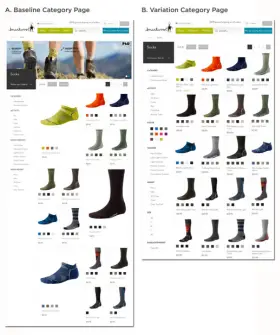Why You’re Crazy to Spend on SEM but Not A/B Testing
If you’re spending money to bring people to your site, you should be doing everything in your power to maximize the chance that those people do what you want in return. A/B testing the landing pages you send paid traffic to is the thing most within your power—the easiest to implement with the highest value—that will increase your return out of your investment in SEM.

In a nutshell, the goal of search engine marketing is to spend money in order to make more money for your business. In the ideal scenario, the amount of money you make from SEM should be more than the amount of money you spend.
This is the concept of return on investment or ROI. In search engine marketing, you invest money by bidding on keywords to get people to come to your website or landing page. The goal is that people who clicked the ad do something in return that makes money for your business, such as sign up or make a purchase.
If you’re spending money to bring people to your site, you should be doing everything in your power to maximize the chance that those people do what you want in return.
A/B testing the landing pages you send paid traffic to is the thing most within your power—the easiest to implement with the highest value—that will increase your return out of your investment in SEM.
The idea of an A/B test is simple. Try two (or more) different things and measure which one performs best. The definition of “performs best” is entirely up to you. You can split test anything: from the actual page you send segments of paid traffic to, to the minutia of on-page elements. (We’ve even found that simply adding a two arrows “>>” to our calls to action button increases conversions.)
Sending traffic to SEM landing pages without A/B testing them is similar to pouring a precious liquid (let’s say a single barrel 12.5 year aged straight rye whiskey) from a wide glass into a thin bottle without a funnel. It’s a surefire way to spill everywhere and waste the sacred (expensive) libations.
Let’s look at how A/B testing creates efficiencies and increased ROI from ad spend. A/B testing can…
-
Increase conversion rate by orders of magnitude. Discovering one big win on a single landing page can increase conversion rates by an order of magnitude because of a very special trait of landing pages: they are commonly templatized. Most companies use landing pages with similar designs for a number of keywords. The main difference between them will be the messaging (you want the messaging to be as relevant as possible to the search term). So if you uncover a conversion win on one landing page, you can immediately test it across your others and have exponentially more conversions on your hands. Exponential conversion increases translates into more ROI for you.
-
Increase conversion value. In addition to conversion quality, A/B testing can also have an effect on conversion quality. This is particularly true for online retail and e-commerce shops. The more optimized the landing page is, then the higher average order value (AOV) or revenue per visitor (RPV) can be.
-
SmartWool tested two variations of a product page and found that the variation increased average RPV by 17.1%. (Check out our full SmartWool case study.)

-
-
Lower ad spend. Testing landing pages can also lead to higher Quality Scores thus a lower cost per click, and decrease in spend. Every keyword for a paid marketing campaign is assigned a Quality Score, which is—according to Google—“an estimate of how relevant your ads, keywords, and landing pages are to a person seeing your ad.” Google evaluates landing page quality as part of its algorithm and rewards campaigns that deliver a high-quality user experience. Advertisers with higher quality scores pay a lower CPC. At scale, even a penny’s difference can translate into hundreds of thousands of dollars in savings. CRO will help you decrease your customer acquisition costs while simultaneously boosting your revenue.
-
Reveal optimization opportunities on other paid channels. The benefits of using a split testing tool on landing pages for search engine marketing traffic extend far beyond this one channel of paid advertising. If you find that a message, image or page flow converts extremely well, you can carry it over to your display ads or offline advertising.
All of this leads to improved ROI. The definition of ROI varies between organizations. Some marketers measure the success of performance marketing based on direct response and in-session revenue. Other marketers place more weight on a carefully defined lifetime customer value (LTV), which captures customer ROI over a period of months or years. A/B testing helps organizations maximize both.
Great marketers get that pay-per-click search engine marketing and A/B testing are tightly interconnected. The paid traffic funnel isn’t operating at its best if the keywords you’re bidding on don’t turn into impressions, the impressions don’t turn into clicks and most importantly, clicks don’t turn into conversions. A/B testing the pages you’re paying eyeballs to visit is inherent to an efficient, ROI-driven approach to paid marketing.
Making A/B testing a default part of your SEM workflow will help you get more value out of your paid search spend. Plus, adding A/B testing to your toolbox of marketing skills will distinguish you from the crowd and give you a shot at becoming a testing hero.
Here is a link to my slide deck about how A/B testing increases ROI on SEM on Slideshare. What do you think? Do you use an AB testing tool on your SEM landing pages? Share some wins in the comments below and let’s make sure no SEM landing page goes un-optimized!
